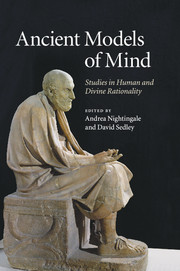Book contents
- Frontmatter
- Contents
- List of contributors
- Introduction
- 1 Plato on aporia and self-knowledge
- 2 Cross-examining happiness: reason and community in Plato's Socratic dialogues
- 3 Inspiration, recollection, and mimēsis in Plato's Phaedrus
- 4 Plato's Theaetetus as an ethical dialogue
- 5 Contemplating divine mind
- 6 Aristotle and the history of skepticism
- 7 Stoic selection: objects, actions, and agents
- 8 Beauty and its relation to goodness in Stoicism
- 9 How dialectical was Stoic dialectic?
- 10 Socrates speaks in Seneca, De vita beata 24–28
- 11 Seneca's Platonism: the soul and its divine origin
- 12 The status of the individual in Plotinus
- A. A. Long: publications 1963–2009
- Bibliography
- Index
3 - Inspiration, recollection, and mimēsis in Plato's Phaedrus
Published online by Cambridge University Press: 06 December 2010
- Frontmatter
- Contents
- List of contributors
- Introduction
- 1 Plato on aporia and self-knowledge
- 2 Cross-examining happiness: reason and community in Plato's Socratic dialogues
- 3 Inspiration, recollection, and mimēsis in Plato's Phaedrus
- 4 Plato's Theaetetus as an ethical dialogue
- 5 Contemplating divine mind
- 6 Aristotle and the history of skepticism
- 7 Stoic selection: objects, actions, and agents
- 8 Beauty and its relation to goodness in Stoicism
- 9 How dialectical was Stoic dialectic?
- 10 Socrates speaks in Seneca, De vita beata 24–28
- 11 Seneca's Platonism: the soul and its divine origin
- 12 The status of the individual in Plotinus
- A. A. Long: publications 1963–2009
- Bibliography
- Index
Summary
For Tony Long:
πολὺ δ᾿ οἶμαι καλλίων σπουδὴ…ὅταν τις…λαβὼν ψυχὴν προσήκουσαν, φυτεύῃ τε καὶ σπείρῃ μετ᾽ ἐπιστήμης λόγους, οἳ ἑαυτοῖς τῷ τε φυτεύσαντι βοηθεῖν ἱκανοὶ καὶ οὐχὶ ἄκαρποι ἀλλὰ ἔχοντες σπέρμα, ὅθεν ἄλλοι ἐν ἄλλοις ἤθεσι φυόμενοι τοῦτ᾽ ἀεὶ ἀθάνατον παρέχειν ἱκανοί…
Plato, Phaedrus 276e–277aPlato's Phaedrus obtrusively foregrounds issues of the rhetoric and reality of madness, inspiration, and mimēsis. In this most “poetic” of dialogues these issues are embodied by an (ironically?) inspired Socrates, and commentators have long been at a loss to nail down the precise ratio of play to seriousness in his myth of the charioteer. This essay examines how the rhetoric of Socrates' famous palinode both raises and defuses problems that have perplexed commentators concerning the status of the poetic, prophetic, and initiatory lives in the scheme of the myth: why are such lives ranked low in one place, yet lauded at the beginning of the speech as the purveyors of the greatest blessings? The palinode, however, provides suggestive indications as to the possibility of a new model of inspiration. Not the least achievement of the speech is to use a conventional framework to present a radical rethinking of the impingement of the divine upon human consciousness. The rhetoric of the speech reflects a changing conception of reality, as a philosophical model of inspiration displaces Plato's (tendentious) presentation of the contemporary cultural realities of divine madness and influence.
- Type
- Chapter
- Information
- Ancient Models of MindStudies in Human and Divine Rationality, pp. 45 - 63Publisher: Cambridge University PressPrint publication year: 2010
- 2
- Cited by



